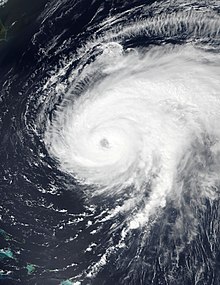
Back Huracán Fiona Spanish Hurrikaani Fiona Finnish Ouragan Fiona French Uragano Fiona Italian Fiona (orkaan) Dutch Furacão Fiona Portuguese Hurricane Fiona SIMPLE Фіона (ураган) Ukrainian 颶風費歐娜 Chinese
 Fiona near peak intensity southwest of Bermuda on September 22 | |
| Meteorological history | |
|---|---|
| Formed | September 14, 2022 |
| Extratropical | September 23, 2022 |
| Dissipated | September 27, 2022 |
| Category 4 major hurricane | |
| 1-minute sustained (SSHWS/NWS) | |
| Highest winds | 140 mph (220 km/h) |
| Lowest pressure | 931 mbar (hPa); 27.49 inHg |
| Overall effects | |
| Fatalities | 29 |
| Damage | ≥$3.09 billion (2022 USD) (Costliest tropical cyclone in Canadian history) |
| Areas affected | Leeward Islands, Puerto Rico, Dominican Republic, Lucayan Archipelago, Bermuda, Atlantic Canada, Saint Pierre and Miquelon, Greenland |
| IBTrACS / [1][2] | |
Part of the 2022 Atlantic hurricane season | |
Hurricane Fiona was a large, powerful, and destructive Category 4 Atlantic hurricane which was the costliest and most intense tropical or post-tropical cyclone to hit Canada on record. It was the sixth named storm, third hurricane and first major hurricane of the 2022 Atlantic hurricane season.
Fiona developed from a tropical wave that emerged from West Africa, before developing into a tropical depression east of the Leeward Islands on September 14. Though under the influence of moderate to strong wind shear, the system was able to strengthen, becoming Tropical Storm Fiona later that same day. On September 16, Fiona passed over Guadeloupe and entered the Caribbean Sea, where atmospheric conditions improved, and strengthened into a hurricane as it approached Puerto Rico two days later. A few hours afterward, the eye of Fiona made landfall along the southwestern coast of Puerto Rico, near Punta Tocon, between the municipalities of Lajas and Cabo Rojo. The hurricane made landfall in the Dominican Republic shortly thereafter, and then strengthened into the first major hurricane of the season. As the storm slowly moved through the Turks and Caicos, it continued to strengthen and reached Category 4 status the following day, while accelerating north. The storm reached peak 1-minute sustained winds of 140 mph (220 km/h) and a minimum pressure of 931 mbar (27.49 inHg). After passing Bermuda and weakening to Category 3 intensity, Fiona quickly transitioned into a large and powerful extratropical cyclone and struck Nova Scotia with sustained winds of 100 mph (155 km/h) early on September 24. Post-tropical Fiona then quickly weakened as it moved through the Gulf of St. Lawrence and over the southeastern Labrador Peninsula. The remnants then dissipated over the Labrador Sea near the southwest coast of Greenland on September 27.
Guadeloupe received near-record rainfall, leaving 40% of the population without water for a few days. Puerto Rico suffered from the worst flooding since Hurricane Maria of 2017, and an island-wide blackout occurred. A third of the territory's population was left without water, and at least 25 people died. In the Dominican Republic and the Turks and Caicos, the islands were pounded by heavy rainfall and strong winds, causing flooding and blackouts. Fiona was the strongest cyclone on record to make landfall in Canada based on atmospheric pressure[3] and was one of the wettest ever recorded in the country as well.
- ^ Cite error: The named reference
TCRwas invoked but never defined (see the help page). - ^ "Billion-Dollar Weather and Climate Disasters". National Centers for Environmental Information. Archived from the original on January 10, 2023. Retrieved January 10, 2023.
- ^ Bob Henson; Jeff Masters (September 24, 2022). "Fiona sets Atlantic Canada reeling; Ian forms in Caribbean". Yale Climate Connections. Archived from the original on September 24, 2022. Retrieved September 25, 2022.